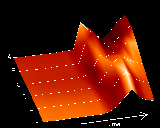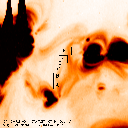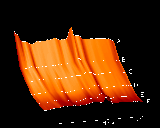All Loops, All the Time
Science Nugget: June 15, 2001
Introduction
When we talk about "coronal loops" in the context of Yohkoh SXT
observations, we mean long, slender structures that are seen in the
corona. We see them in the SXT images because the plasma contained in
these objects is very hot, and dense enough to emit appreciable amounts of
X-rays. The loops are formed by magnetic fields that come up into the
corona from the lower regions and loop back down into the Sun. The
charged particles in the plasma are constrained to move along the path
created by the magnetic fields -- for all practical purposes, one can
assume that the plasma does not move perpendicular to the magnetic field
lines; and so the X-ray emitting plasma tells us both the location and
orientation of coronal magnetic fields.
Any image of the hot corona will reveal lots of loops (except during the
doldrums of solar minimum, perhaps), as one can easily demonstrate simply
by checking out the latest SXT image (at LMSAL, at ISAS,
at MSSL).
In fact, due to their ubiquitous presence and fundamental physical
structure, coronal loops have often been referred to as the "building
blocks of the corona". Thus, the theme of the corona seems to be,
"All Loops, All the Time."
Lots of our Weekly Nuggets have dealt with loops. Here are a few:
[1],
[2],
[3];
try the Nugget search tool to
find more.
In a famous
montage of SXT images, examples of the varying appearances of coronal
loops were highlighted. This week, we'll focus not on the shape of loops,
but on the interesting behavior that these "building blocks" occasionally
exhibit. With two examples, we will explore some activity that indicates
the flow of plasma, or at least of energy, along the length of the loops.
The Particulars
Example One
 For Example Number One, we have a loop from 9-Jun-2001. The image
at left shows the location on the Sun. In the movie linked below, we can
see that the loop appears to brighten first at the north end, and the
brightness appears to propagate down to the southern end of the loop.
After that, it seems that the "wave" of brightness travels back up the
loop, to the northern end again. Please see the movie:
For Example Number One, we have a loop from 9-Jun-2001. The image
at left shows the location on the Sun. In the movie linked below, we can
see that the loop appears to brighten first at the north end, and the
brightness appears to propagate down to the southern end of the loop.
After that, it seems that the "wave" of brightness travels back up the
loop, to the northern end again. Please see the movie:

Java Script
(544 kbyte) -- MPEG (36 kbyte)
To emphasize this behavior, we can station ourselves at various positions
along the length of the loop, and monitor the changing brightness at each
of those locations. (We did this in an earlier
Nugget too, for reference.)
The images below show the locations where we measured the changing
brightness (left), and the light curves from those 6 locations (right).
In the light curve plot, time increases from left to right, and we've
indicated the position along the loop by the letters A-F. (Click to
enlarge.)
At each of the six locations, the traveling brightness shows up as a peak
in the corresponding light curve. As the "wave" moves from A to F and
back to A, the surface plot above displays a V shape. (If it
helps, an alternative version of the surface plot, with time stamps to
show when the peak occurs at each location, is linked here. The slope
of the ridges in the surface plot indicate the speed of propagation of the
brightness. In this case, we find speeds around 230-310 km/sec.
Example Two
 For Example Number Two, we offer a loop from one day earlier,
9-Jun-2001. The location is shown at left (click to enlarge), and a
movie is linked below. What you'll see is a few recurrent brightenings at
the southern footpoint, and then the loop brightens from the south to the
north. Not once, but twice -- and the northern end of the moving
brightening does not appear to be at the same place both times.
For Example Number Two, we offer a loop from one day earlier,
9-Jun-2001. The location is shown at left (click to enlarge), and a
movie is linked below. What you'll see is a few recurrent brightenings at
the southern footpoint, and then the loop brightens from the south to the
north. Not once, but twice -- and the northern end of the moving
brightening does not appear to be at the same place both times.

Java Script
(1.4 Mbyte) -- MPEG (74 kbyte)
The same light curve treatment shows the difference in the propagation of
X-ray brightness. Again, the images below show the locations where we
measured the changing brightness (left), and the light curves from those 6
locations (right). In the light curve plot, time increases from left to
right, and we've indicated the position along the loop by the letters A-F.
(Click to enlarge.)
Rather than a V shape, the two traveling brightnesses appear in
this surface plot as distinct unconnected ridges. Since the brightness
peaks at different times in the different locations, the ridges are
slightly slanted. As before, the slope of the ridges in the plot indicate
the speed of propagation; the speed here is about 230 km/sec, similar to
that seen in the other loop example. (A version with time tickmarks is
shown here.)
What's Going On?
The images from Yohkoh SXT show the locations of hot plasma. So
when we see something like a propagating brightness, we have to ask
ourselves, do we see plasma moving from one end of the loop to the other,
or are we seeing heat move from one end to the other? Either is possible:
If the plasma actually moves along the loop, then one ought to see the
loop brightening from end to end, as the hot plasma emits radiation. On
the other hand, if the plasma doesn't move, but gets heated at one end of
the loop, then the hotter stuff will radiate X-rays, and also conduct the
heat further along the loop: one would see different parts of the loop
light up as they get heated.
In the present case, there are circumstantial clues to indicate that
we're seeing actual motion of plasma. In Example One, the "round trip"
propagation of the brightness enhancement is more likely to be due to the
motion of material -- probably some plasma is heated at the southern end
of the loop, and then moves northward along the loop to form the "return
leg" of the trip. In Example Two, we can clearly see that the "wave" of
brightness starts from the southern end of the loop, but in the two
episodes goes to two different places in the northern end. In both these
examples, plasma motion seems a more likely explanation for the
observations.
As always, this is only a first impression, and closer analysis
(including possibly comparison with data from SOHO and/or TRACE) may prove
the conclusions of this Nugget to be so much hogwash.
Aside: Eclipse Planning -- Updated June 19
Please don't forget that the coming week will see a total eclipse of the
Sun. On June 21, 2001, the moon will temporarily move directly between
the Earth and the Sun, blocking our view. For a discussion of the
appearance of the Sun during that time, please see last week's Nugget. Yohkoh will watch the
solar eclipse, and probably attempt some observations similar to those
during the February 1998
and August 1999 eclipses.
What SXT will see: SXT will see the moon sweep in over the Sun,
stop, and reverse itself. An hour and a half later, this will happen
again. Simulations of these two events, based on the orbital parameters
of Yohkoh, are linked below. In each case, we've only shown the
intervals when Yohkoh will be in daylight; the movie frames are 2
minutes apart. The SXT image in the middle is from May 25, one rotation
before the eclipse.
Event 1

Java Script (2 Mbyte) --
MPEG (295 kbyte)
Event 2

Java Script (2 Mbyte) --
MPEG (295 kbyte)
June 15, 2001
D. McKenzie
<mckenzie@isass1.solar.isas.ac.jp>.
 For Example Number One, we have a loop from 9-Jun-2001. The image
at left shows the location on the Sun. In the movie linked below, we can
see that the loop appears to brighten first at the north end, and the
brightness appears to propagate down to the southern end of the loop.
After that, it seems that the "wave" of brightness travels back up the
loop, to the northern end again. Please see the movie:
For Example Number One, we have a loop from 9-Jun-2001. The image
at left shows the location on the Sun. In the movie linked below, we can
see that the loop appears to brighten first at the north end, and the
brightness appears to propagate down to the southern end of the loop.
After that, it seems that the "wave" of brightness travels back up the
loop, to the northern end again. Please see the movie:








